Long-Term Forecast of Energy Demand towards a Sustainable Future in Renewable Energies Focused on Geothermal Energy in Peru (2020–2050): A LEAP Model Application
Abstract
1. Introduction
2. Electric Power Generation in Peru
2.1. Structure of Peruvian Electricity Generation
2.2. Analysis of Electric Power Generation
2.3. Analysis of Electric Power Demand
2.4. Relevant Information about the Energy Sector in Peru
3. Methodology
3.1. Structure of the LEAP Model in Peru
3.2. Base Values and Assumptions for the Peruvian LEAP Model
3.3. Description of the Scenario Design
3.3.1. S1: Business-as-Usual
3.3.2. S2: Energy Efficiency
3.3.3. S3: Geothermal Energy
4. Results and Discussions
4.1. Projection of the Total Demand for Electrical Energy
4.2. Projection of Installed Capacity for Demand
4.3. Projection of Carbon Dioxide Equivalent Emissions CO2e
5. Conclusions
- The study analyzes the energy demand, installed capacity, and emissions (CO2e) of the electric mix in Peru through three scenarios defined as the Business-as-Usual scenario, denoted as S1, the Energy Efficiency scenario, denoted as S2, and the Geothermal Energy scenario, denoted as S3. This result shows a very similar total production of energy expressed in GWh, even considering that for S3, the installed capacity is significantly lower than the others. As shown, right after the year 2045, S3 is projected to start showing good results.
- Scenario S2, developed considering energy efficiency, builds upon scenario S1 but includes investment in technology and reduction of transformation and distribution losses. To represent this, the peak load has been reduced to reflect this efficiency over the years. The details of this consideration are not expressed extensively because they are not within the scope of this article. However, the improvement of the SEIN and/or the application of energy storage methods could be considered at this stage.
- The results of scenario S2 reveal that the country would experience lower energy demand over time, highlighting its efficiency compared to scenario S3. The latter proposed the implementation of geothermal energy as the main strategy without specifically considering energy efficiency. Scenario S2 stands out by focusing on technological improvements and energy efficiency, resulting in an optimization of energy consumption over time. In contrast, scenario S3, by focusing on the introduction of geothermal energy as the main innovation, could face challenges in terms of the overall efficiency of the system.
- Under a more detailed evaluation, it is observed that scenario S3, despite expectations, presented long-term results that are lower in terms of installed capacity. This result becomes evident when analyzing the last 5 years (2045–2050), a period in which scenario S3 demonstrated requiring a lower amount of energy compared to scenarios S1 and S2. Additionally, scenario S3 reflects not only superior energy efficiency but also a substantial reduction in greenhouse gas emissions during the same period of 2045–2050, compared to scenarios S1 and S2.
- Finally, the exclusion of energy efficiency considerations in the evaluation of scenario S3 aims to analyze its advantages and disadvantages impartially. Although scenario S2 highlights improvements by focusing on technological investments and energy efficiency without incorporating new energy sources, the idea is raised that optimal implementation could arise from combining both strategies. Furthermore, the inclusion of geothermal energy as a new energy source is presented as a viable option that can complement and enhance improvements derived from energy efficiency technologies.
- These results underscore the importance of considering not only new energy sources, such as geothermal but also strategies that improve energy efficiency at all levels of the system.
Author Contributions
Funding
Institutional Review Board Statement
Informed Consent Statement
Data Availability Statement
Conflicts of Interest
References
- United Nations. What Is Climate Change? Available online: https://www.un.org/en/climatechange/what-is-climate-change (accessed on 30 January 2024).
- United Nations. Your Guide to Climate Action: Home Energy. Available online: https://www.un.org/en/actnow/home-energy (accessed on 30 January 2024).
- International Energy Agency. Electricity Market Report Update: Outlook for 2023 and 2024; IEA: Paris, France, 2023. [Google Scholar]
- British Petroleum. bp Energy Outlook 2023 Edition. 2023. Available online: https://www.bp.com/content/dam/bp/business-sites/en/global/corporate/pdfs/energy-economics/energy-outlook/bp-energy-outlook-2023.pdf (accessed on 25 May 2024).
- Streimikiene, D.; Simanaviciene, Z.; Kovaliov, R. Corporate social responsibility for implementation of sustainable energy development in Baltic States. Renew. Sustain. Energy Rev. 2009, 13, 813–824. [Google Scholar] [CrossRef]
- Yoo, S.-H.; Kwak, S.-Y. Electricity consumption and economic growth in seven South American countries. Energy Policy 2010, 38, 181–188. [Google Scholar] [CrossRef]
- Kale, R.V.; Pohekar, S.D. Electricity demand and supply scenarios for Maharashtra (India) for 2030: An application of long range energy alternatives planning. Energy Policy 2014, 72, 1–13. [Google Scholar] [CrossRef]
- McPherson, M.; Karney, B. Long-term scenario alternatives and their implications: LEAP model application of Panama’s electricity sector. Energy Policy 2014, 68, 146–157. [Google Scholar] [CrossRef]
- Perwez, U.; Sohail, A.; Hassan, S.F.; Zia, U. The long-term forecast of Pakistan’s electricity supply and demand: An application of long range energy alternatives planning. Energy 2015, 93, 2423–2435. [Google Scholar] [CrossRef]
- Vidoza, J.A.; Gallo, W.L. Projection of fossil fuels consumption in the Venezuelan electricity generation industry. Energy 2016, 104, 237–249. [Google Scholar] [CrossRef]
- Bautista, S. A sustainable scenario for Venezuelan power generation sector in 2050 and its costs. Energy Policy 2012, 44, 331–340. [Google Scholar] [CrossRef]
- Pirker, G.; Wimmer, A. Sustainable power generation with large gas engines. Energy Convers. Manag. 2017, 149, 1048–1065. [Google Scholar] [CrossRef]
- Vandewalle, J.; Bruninx, K.; D’haeseleer, W. Effects of large-scale power to gas conversion on the power, gas and carbon sectors and their interactions. Energy Convers. Manag. 2015, 94, 28–39. [Google Scholar] [CrossRef]
- United Nations. Paris Agreement. 2015. Available online: https://unfccc.int/sites/default/files/english_paris_agreement.pdf (accessed on 25 May 2024).
- United Nations. Kyoto Protocol to the United Nations Framework Convention on Climate Change. 1997. Available online: https://unfccc.int/kyoto_protocol (accessed on 25 May 2024).
- International Renewable Energy Agency. Renewable Energy Market Analysis—Latin America; IRENA: Masdar City, United Arab Emirates, 2016. [Google Scholar]
- CIA World Factbook. Consumption of Electricity per Capita by Country-Comparative Map of Countries-South. 2020. Available online: https://www.indexmundi.com/map/?t=0&v=81000&r=sa&l=es (accessed on 7 December 2023).
- Tamayo, J.; Salvador, J.; Vásquez, A.; Vilches, C. La Industria de la Electricidad en el Perú: 25 Años de Aportes al Crecimiento Económico del País; Osinergmin: Lima, Peru, 2017. [Google Scholar]
- Cox, W. Demographia World Urban Areas 19th Annual Edition. 2023. Available online: http://www.demographia.com/db-worldua.pdf (accessed on 7 December 2023).
- Instituto Nacional de Estadística e Informática. Electrificación: Acceso a los Servicios Básicos en el Perú; INEI: Lima, Peru, 2021. [Google Scholar]
- Perupetro S.A. Estadística Anual de Hidrocarburos; Perupetro S.A.: Lima, Peru, 2022. [Google Scholar]
- Ministerio de Energía y Minas. Revista Estadística “En cifras”—Electricidad. 2022. Available online: https://www.gob.pe/institucion/minem/colecciones/1486-revista-en-cifras (accessed on 1 December 2023).
- Revista Energía. Energías Renovables: El Futuro de la Electricidad. 2023. Available online: https://revistaenergia.pe/wp-content/uploads/2023/05/REVISTA-32-.pdf (accessed on 20 October 2023).
- Energia Estratégica. Aseguran que Perú Cuenta con un Potencial Geotérmico de 3.000 MW, que no es Aprovechado. 2020. Available online: https://www.energiaestrategica.com/aseguran-que-peru-cuenta-con-un-potencial-geotermico-de-3-000-mw-que-no-es-aprovechado/ (accessed on 25 May 2024).
- United Nations. Sustainable Development Goals. Available online: https://www.un.org/sustainabledevelopment/energy/ (accessed on 25 May 2024).
- Banco Central de Reserva del Perú. Estimaciones del Balance Oferta—Demanda en el Sector Eléctrico 2021–2024. 2021. Available online: https://www.bcrp.gob.pe/docs/Publicaciones/Reporte-Inflacion/2021/junio/ri-junio-2021-recuadro-1.pdf (accessed on 1 December 2023).
- Schmerler, D.; Velarde, J.C.; Rodríguez, A.; Solís, B. Energías Renovables: Experiencia y Perspectivas en la Ruta del Perú Hacia la Transición Energética; Osinergmin: Lima, Peru, 2019. [Google Scholar]
- Vásquez, A.; Tamayo, J.; Vilches, C. La Industria de la Energía Renovable en el Perú: 10 Años de Contribuciones a la Mitigación del Cambio Climático; Osinergmin: Lima, Peru, 2017. [Google Scholar]
- Apoyo & Asociados. ENGIE Energía Perú S.A. Reporte de Clasificación. 2023. Available online: https://engie-energia.pe/wp-content/uploads/2023/11/Engie-0923.pdf (accessed on 25 May 2024).
- ENGIE. ENGIE to Replace 1 GW of Coal Assets with 1 GW of Renewables. 2019. Available online: https://www.engie.com/sites/default/files/assets/documents/2020-01/10dec-2-pr-chile-en-v6_VA.pdf (accessed on 1 December 2023).
- WSP. Plan de Abandono Parcial de la Central Termoeléctrica Ilo 21. 2023. Available online: https://www.wsp.com/es-pe/proyectos/plan-de-abandono-parcial-de-la-central-termoelectrica-ilo-21 (accessed on 25 May 2024).
- ENGIE. Memoria Anual. 2019. Available online: https://engie-energia.pe/wp-content/uploads/2020/10/Memoria-Anual-2019-vweb.pdf (accessed on 25 May 2024).
- Ministerio de Energía y Minas. Anuarios Estadísticos; MINEM: Lima, Peru, 2020–2022. [Google Scholar]
- Apoyo & Asociados. Sector Eléctrico Peruano 2022: Reporte Sectorial. 2022. Available online: https://www.aai.com.pe/wp-content/uploads/2023/06/Sectorial-Sector-El%C3%A9ctrico-Dic-2022.pdf (accessed on 25 May 2024).
- Instituto Nacional de Estadística e Informática. Estado de la Población Peruana; INEI: Lima, Peru, 2020. [Google Scholar]
- Ministerio de Energía y Minas. Tres Proyectos de Generación Eléctrica con Energía Renovables Entran en Fase de Operación Comercial Durante el 2020. 2020. Available online: https://www.gob.pe/institucion/minem/noticias/86946-tres-proyectos-de-generacion-electrica-con-energia-renovables-entran-en-fase-de-operacion-comercial-durante-el-2020 (accessed on 25 May 2024).
- Ministerio de Energía y Minas. Política Energética Nacional del Perú 2010–2040; MINEM: Lima, Peru, 2020. [Google Scholar]
- Camisea. ¿Qué es Camisea? Available online: https://camiseaesenergia.pe/que-es-camisea/ (accessed on 25 May 2024).
- Lee, E.; Hengesh, J.; Nyman, D. Landslide-related ruptures of the Camisea pipeline system, Peru. Q. J. Eng. Geol. Hydrogeol. 2009, 42, 251–259. [Google Scholar] [CrossRef]
- Heaps, C.G. LEAP: The Low Emissions Analysis Platform; [Software Version: 2020.1.112]; Stockholm Environment Institute: Somerville, MA, USA, 2020; Available online: https://leap.sei.org (accessed on 3 April 2024).
- Nieves, J.A.; Aristizábal, A.J.; Dyner, I.; Báez, O.; Ospina, D.H. Energy demand and greenhouse gas emissions analysis in Colombia: A LEAP model application. Energy 2019, 169, 380–397. [Google Scholar] [CrossRef]
- Mirjat, N.H.; Uqaili, M.A.; Harijan, K.; Walasai, G.D.; Mondal, M.A.H.; Sahin, H. Long-term electricity demand forecast and supply side scenarios for Pakistan (2015–2050): A LEAP model application for policy analysis. Energy 2018, 165, 512–526. [Google Scholar] [CrossRef]
- Chen, R.; Rao, Z.; Liu, G.; Chen, Y.; Liao, S. The long-term forecast of energy demand and uncertainty evaluation with limited data for energy-imported cities in China: A case study in Hunan. Energy Procedia 2019, 160, 396–403. [Google Scholar] [CrossRef]
- Rivera-González, L.; Bolonio, D.; Mazadiego, L.F.; Naranjo-Silva, S.; Escobar-Segovia, K. Long-Term Forecast of Energy and Fuels Demand Towards a Sustainable Road Transport Sector in Ecuador (2016–2035): A LEAP Model Application. Sustainability 2020, 12, 472. [Google Scholar] [CrossRef]
- Ministerio de Energía y Minas. Plan Energético Nacional 2014–2025; MINEM: Lima, Peru, 2021. [Google Scholar]
- ENEL. Wayra I: La Energía del Viento Impulsando una Nueva Era. Available online: https://www.enel.pe/es/sostenibilidad/wayra-i-la-primera-central-eolica-de-enel-en-peru.html (accessed on 25 May 2024).
- ENEL. Central Solar Clemesí: Proyecto ya se Encuentra al 60 % de Avance. Available online: https://www.enel.pe/es/conoce-enel/prensa/press/d202303-central-solar-clemesi--proyecto-ya-se-encuentra-al-60---de-avanc.html (accessed on 25 May 2024).
- Statkraft. Solar Lab en Junín Permitirá Evaluar Tres Nuevas Tecnologías Fotovoltaicas en Zona Alta del Perú. 2021. Available online: https://www.statkraft.com.pe/comunicaciones/noticias/solarlab-en-junin-permitira-evaluar-el-comportamiento-de-cuatro-nuevas-tecnologias-en-zona-alta-del-peru/ (accessed on 25 May 2024).
- Cordova, E.V.; Aquino, L.T.; Cordova, E.V.; Hinostroza, S.C. Project to Develop a Geothermal System to Generate Electricity in Peru. Int. J. Energy Econ. Policy 2022, 12, 311–322. [Google Scholar] [CrossRef]
- Revista Energía. La Energía Geotérmica es una Oportunidad de oro para el Perú. 2022. Available online: https://revistaenergia.pe/la-energia-geotermica-es-una-oportunidad-de-oro-para-el-peru/ (accessed on 25 May 2024).
- Seequent. Combustible Verde a Partir de Energía verde: Cómo la Energía geotérmica Puede Producir Hidrógeno. 2022. Available online: https://www.seequent.com/es/combustible-verde-a-partir-de-energia-verde-como-la-energia-geotermica-puede-producir-hidrogeno/ (accessed on 13 January 2024).
- ENEL Green Power. Todas las Ventajas de la Energía Geotérmica. Available online: https://www.enelgreenpower.com/es/learning-hub/energias-renovables/energia-geotermica/ventajas (accessed on 13 January 2024).
- van der Molen, J.; Peters, E.; Jedari-Eyvazi, F.; van Gessel, S.F. Dual hydrocarbon–geothermal energy exploitation: Potential synergy between the production of natural gas and warm water from the subsurface. Neth. J. Geosci. 2019, 98, e12. [Google Scholar] [CrossRef]
- Schlömer, S.; Bruckner, T.; Fulton, L.; Hertwich, E.; McKinnon, A.; Perczyk, D.; Roy, J.; Schaeffer, R.; Sims, R.; Smith, P.; et al. Annex III: Technology-Specific Cost and Performance Parameters: Climate Change 2014: Mitigation of Climate Change. Contribution of Working Group III to the Fifth Assessment Report of the Intergovernmental Panel on Climate Change; Cambridge University Press: Cambridge, UK; New York, NY, USA, 2014. [Google Scholar]
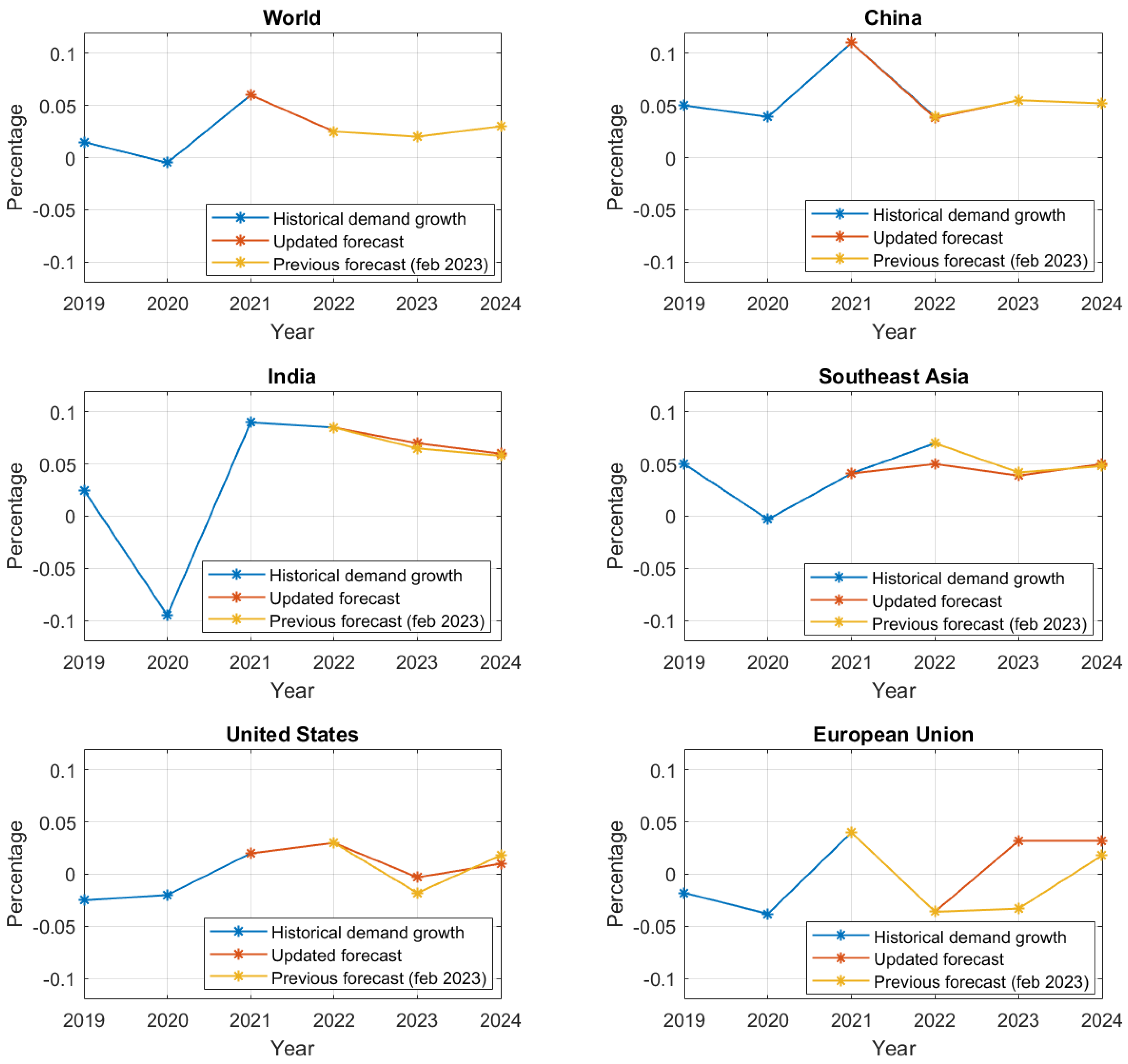
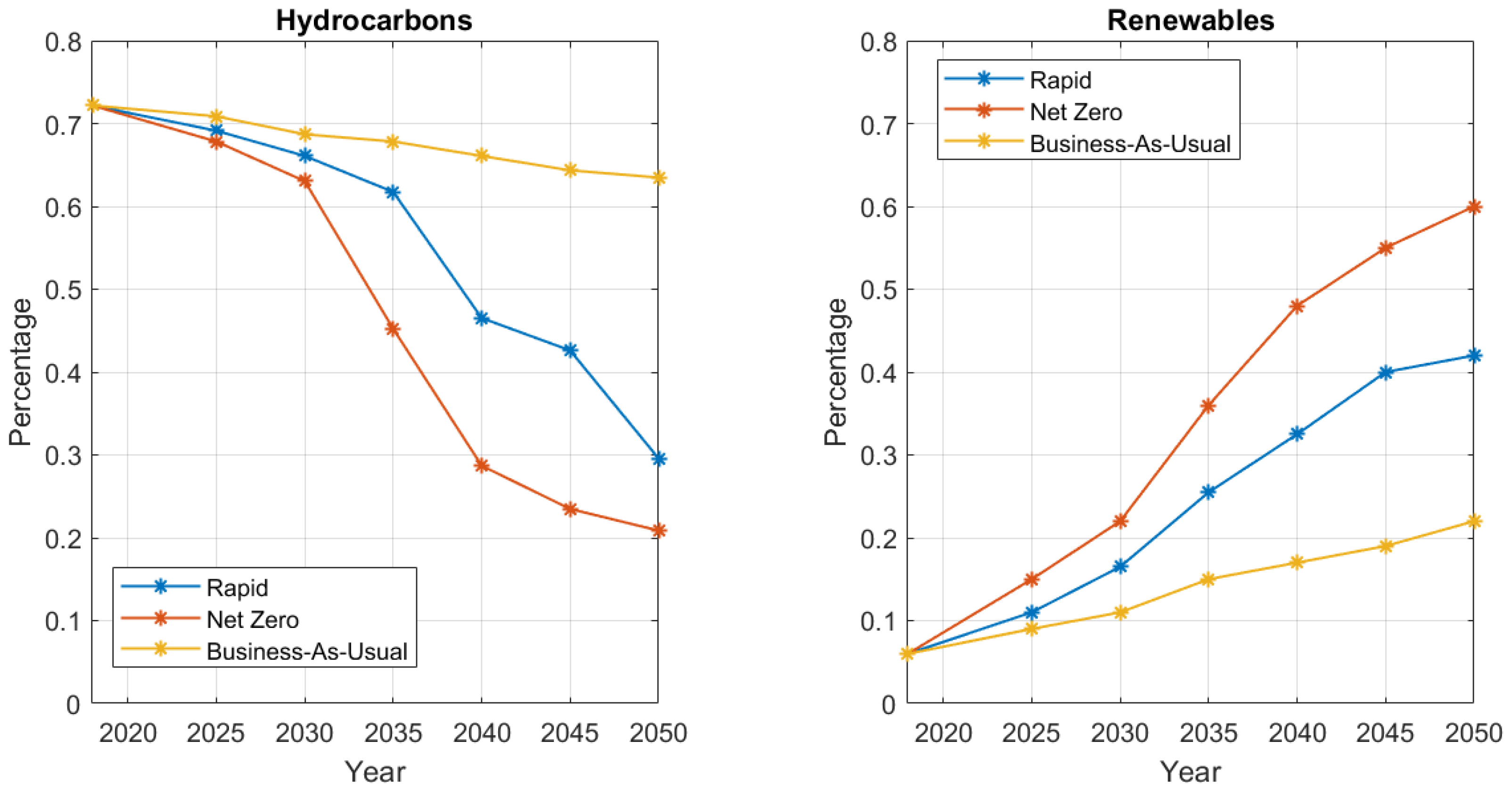

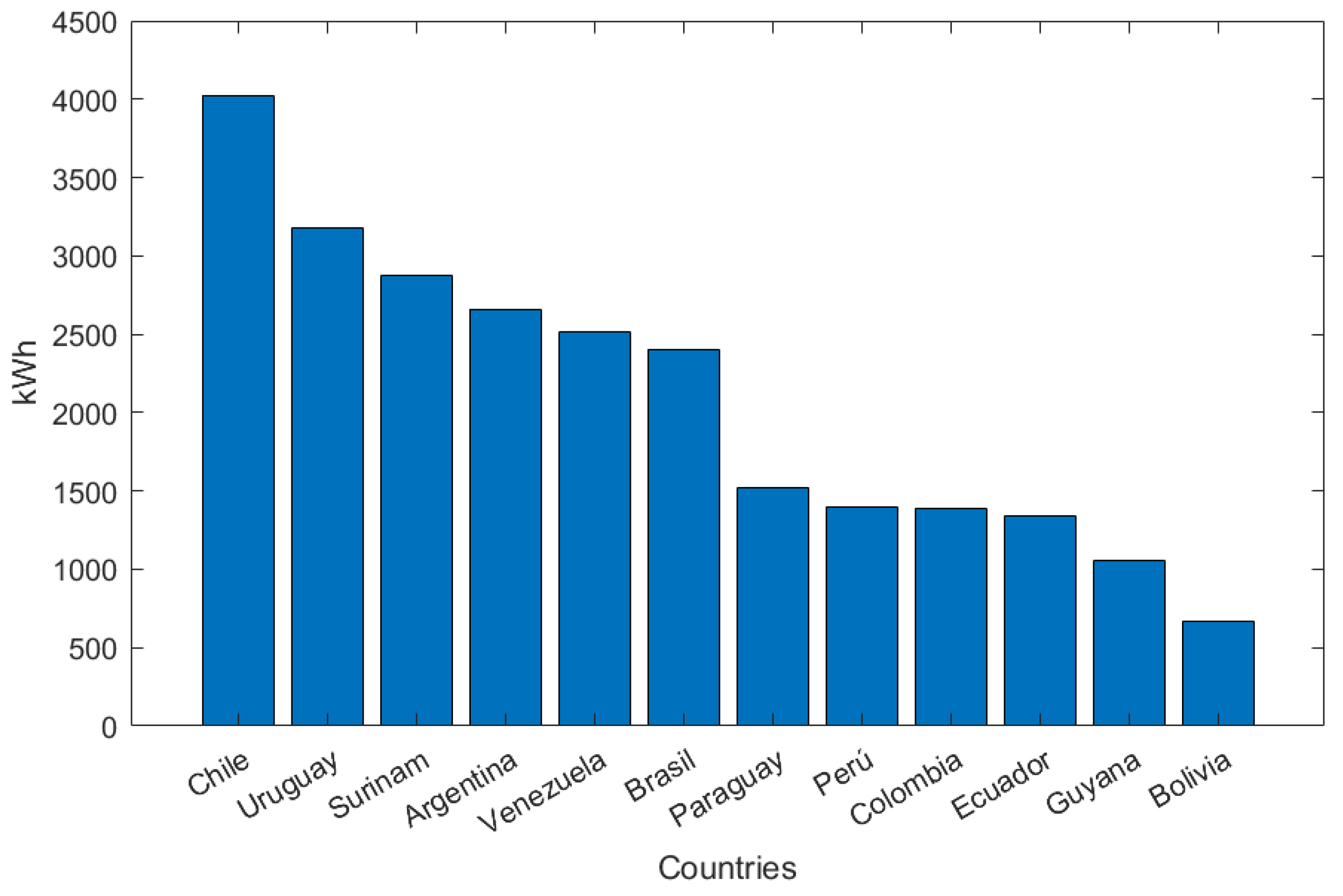
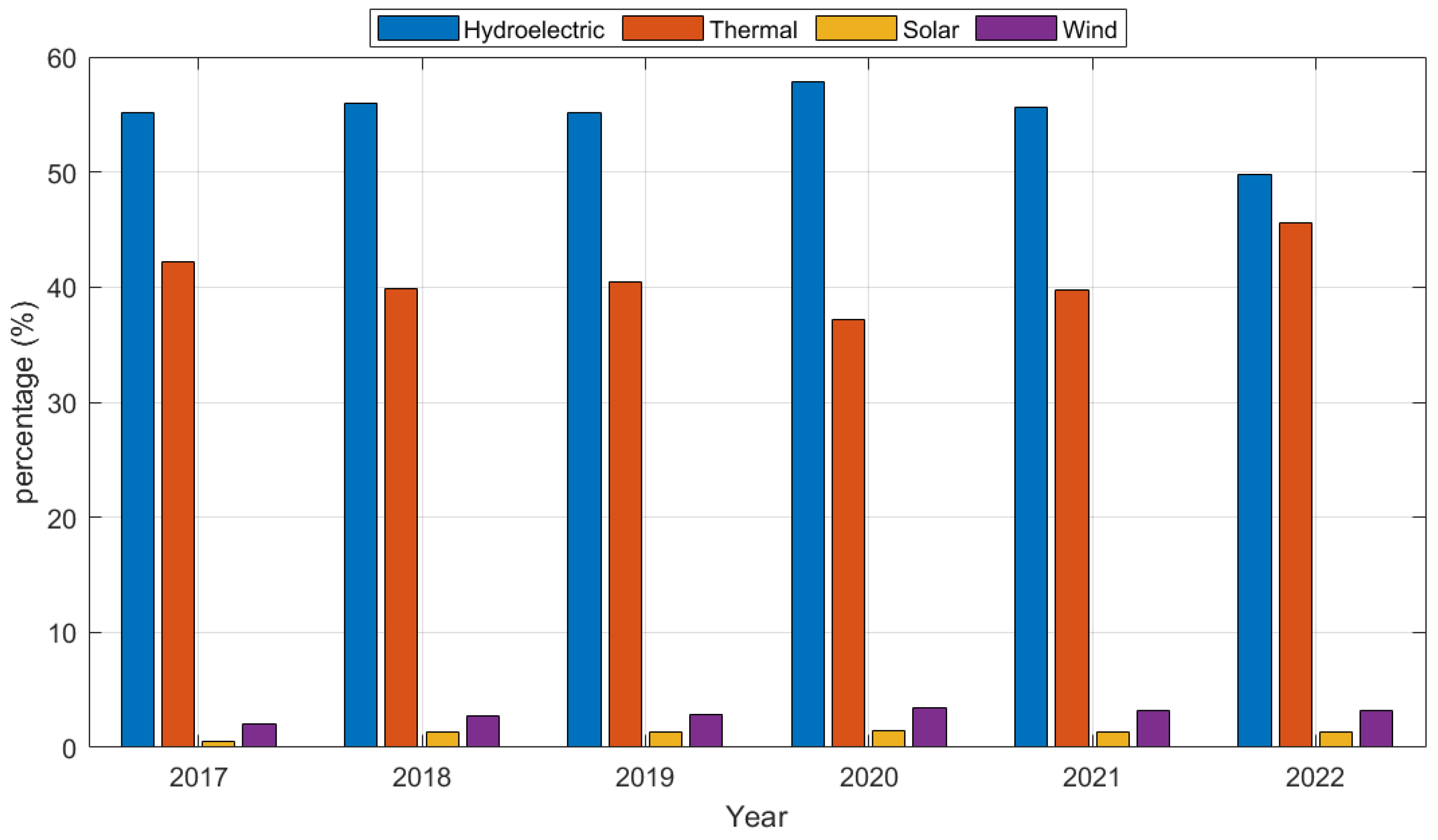
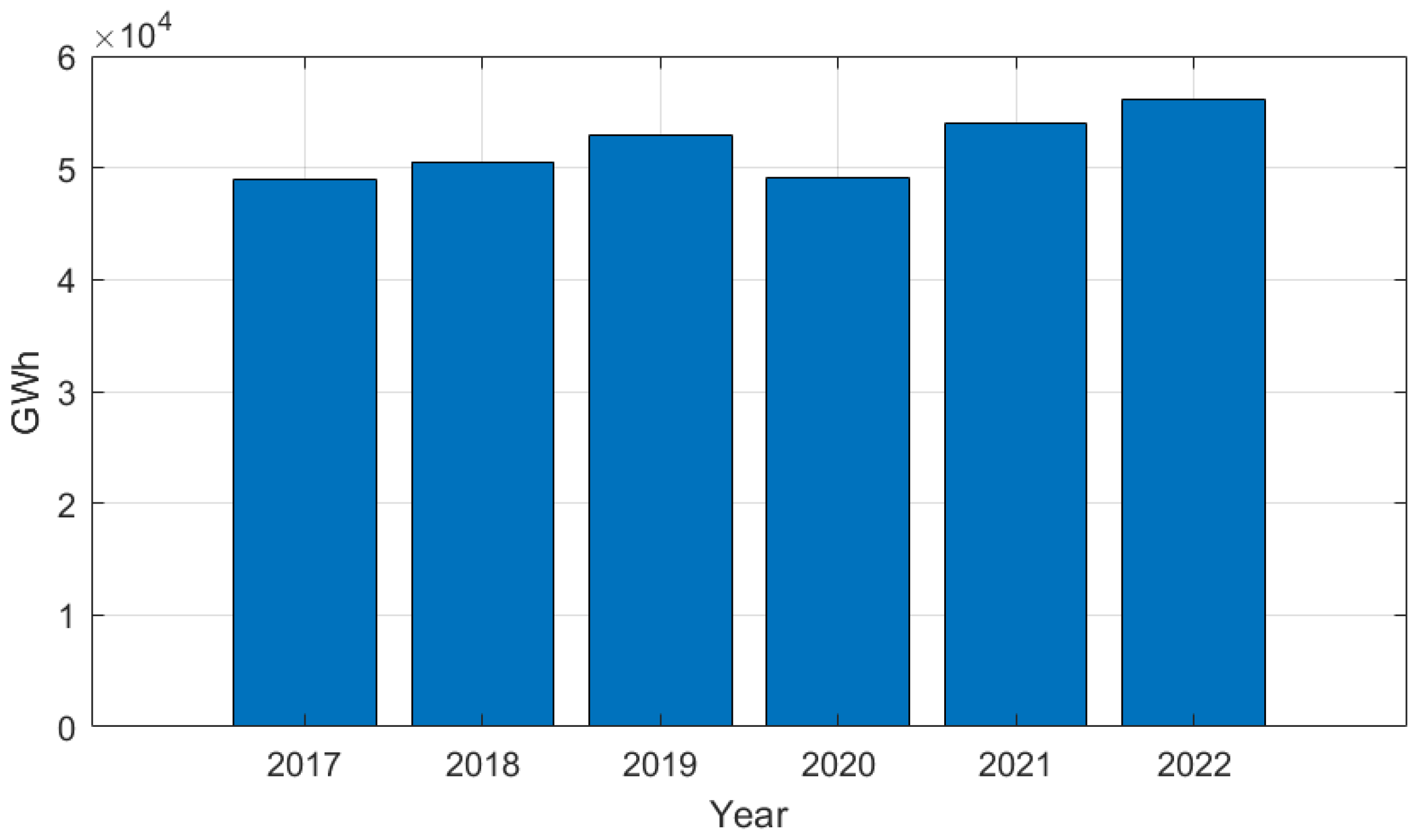
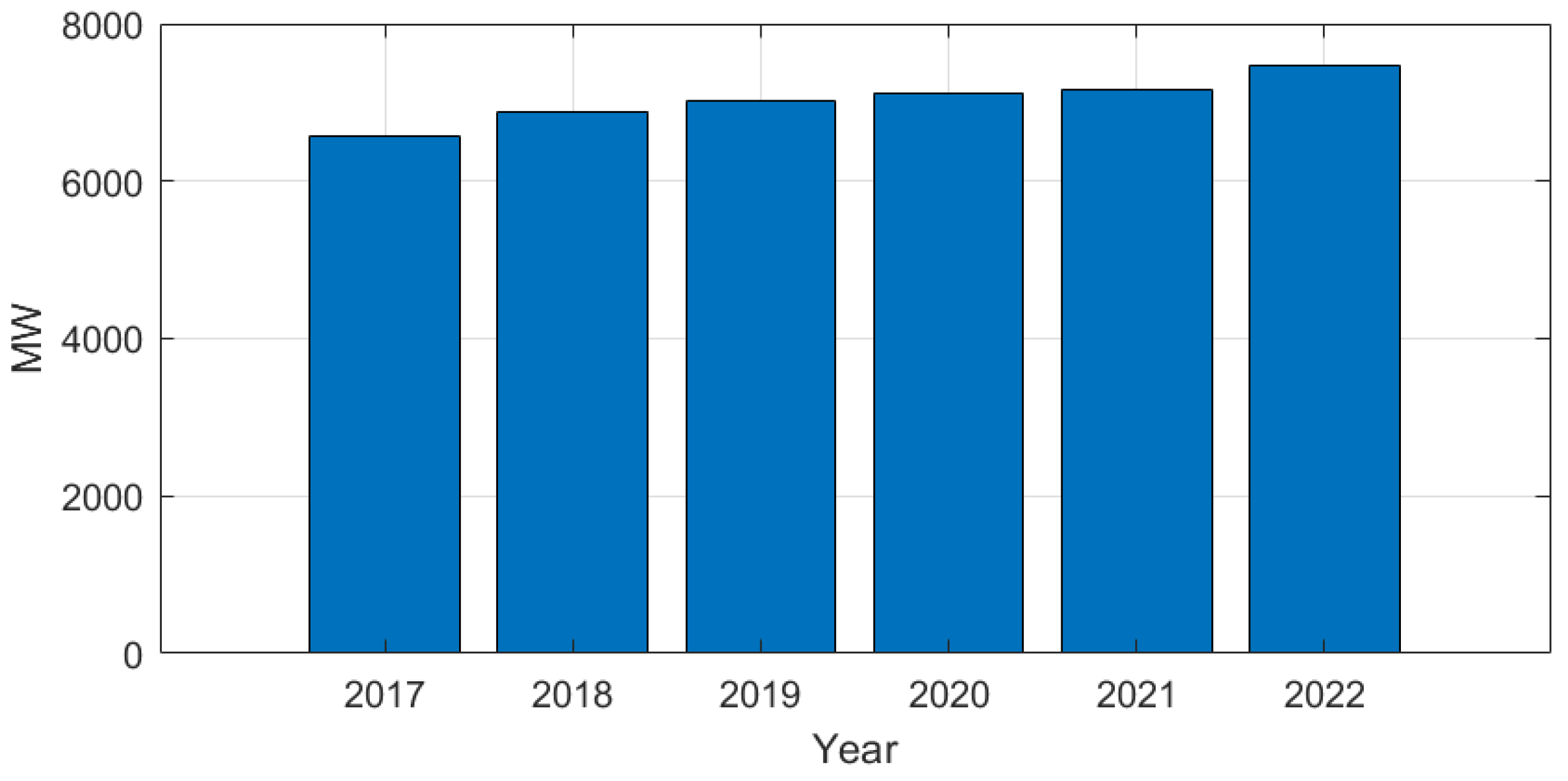
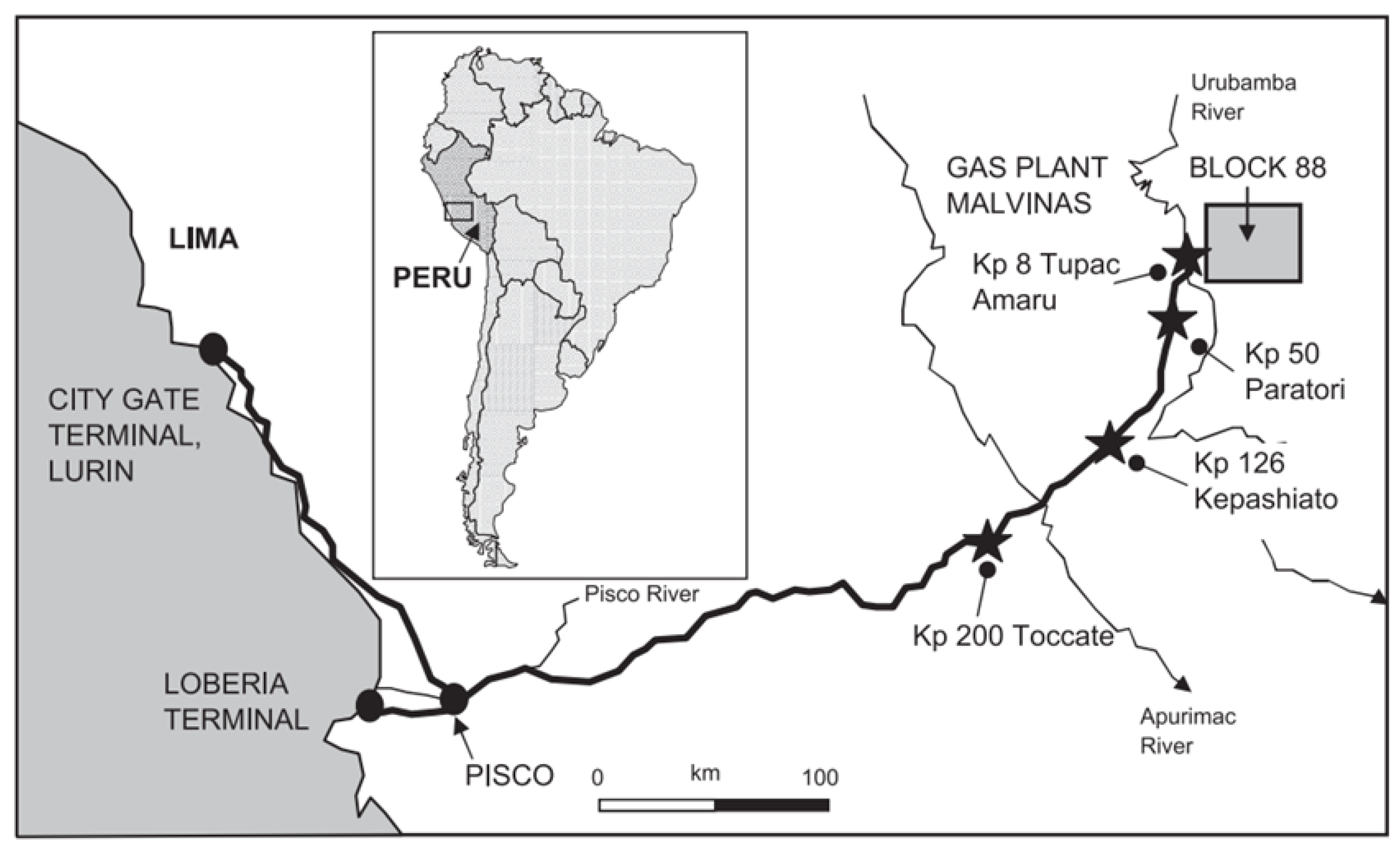


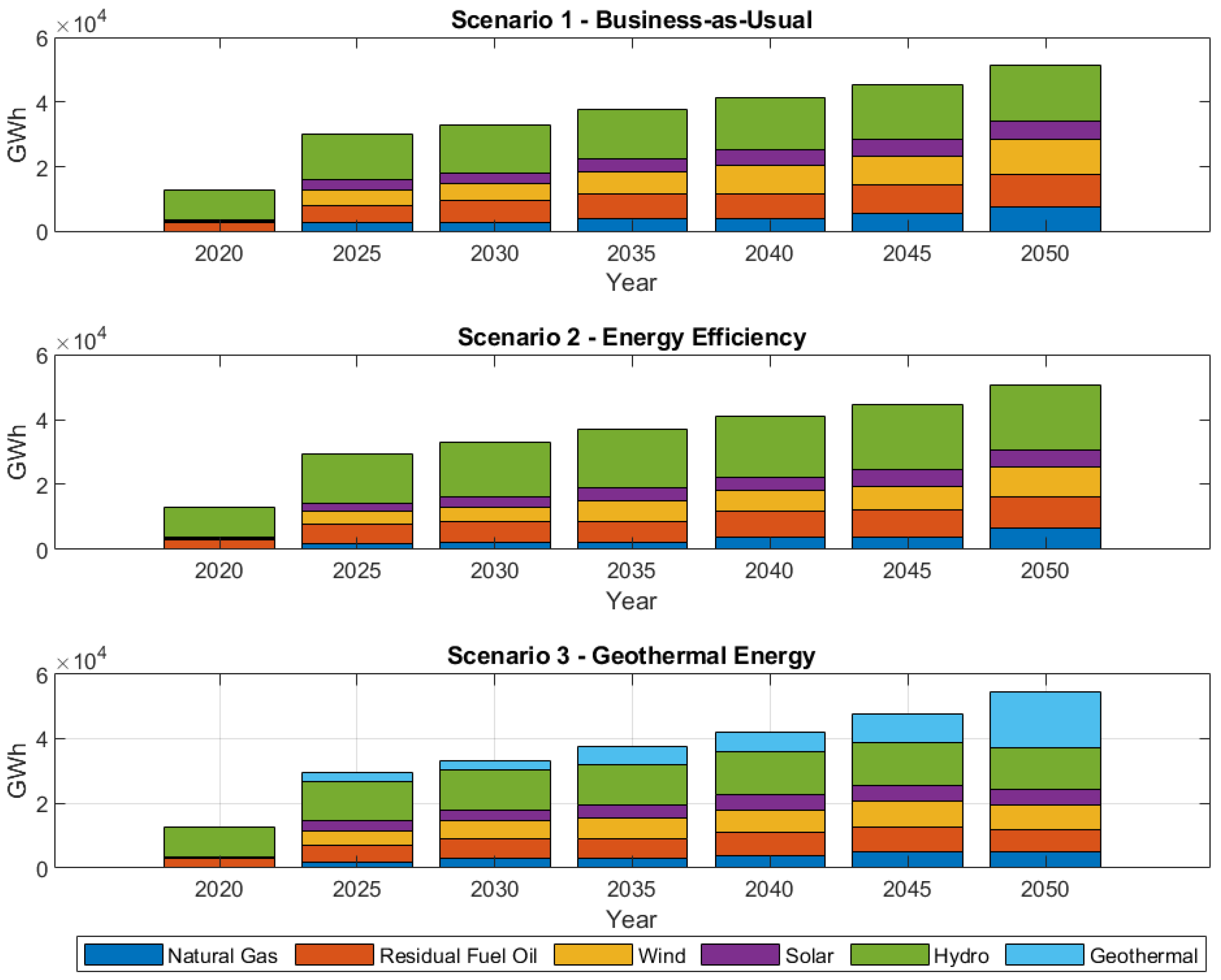

| Parameters | Description |
|---|---|
| Population in 2020–2050 | 32.6–39.7 million people [35] |
| Gross Electricity Generation (GEG) | 52,743.71 (GWh) [22] |
| Gross Electricity per capita Consumption | 1616.3 (kWh/hab) [22] |
| Gross Electricity per capita Generation | 1404.9 (kWh/hab) [22] |
| Losses in Distribution Systems | 9.6% [22] |
| Environmental Directives | Peruvian Energy Policy [37] |
Disclaimer/Publisher’s Note: The statements, opinions and data contained in all publications are solely those of the individual author(s) and contributor(s) and not of MDPI and/or the editor(s). MDPI and/or the editor(s) disclaim responsibility for any injury to people or property resulting from any ideas, methods, instructions or products referred to in the content. |
© 2024 by the authors. Licensee MDPI, Basel, Switzerland. This article is an open access article distributed under the terms and conditions of the Creative Commons Attribution (CC BY) license (https://creativecommons.org/licenses/by/4.0/).
Share and Cite
De la Cruz Torres, D.G.; Mazadiego, L.F.; Bolonio, D.; Pons-Esparver, R.R. Long-Term Forecast of Energy Demand towards a Sustainable Future in Renewable Energies Focused on Geothermal Energy in Peru (2020–2050): A LEAP Model Application. Sustainability 2024, 16, 4964. https://doi.org/10.3390/su16124964
De la Cruz Torres DG, Mazadiego LF, Bolonio D, Pons-Esparver RR. Long-Term Forecast of Energy Demand towards a Sustainable Future in Renewable Energies Focused on Geothermal Energy in Peru (2020–2050): A LEAP Model Application. Sustainability. 2024; 16(12):4964. https://doi.org/10.3390/su16124964
Chicago/Turabian StyleDe la Cruz Torres, Diego G., Luis F. Mazadiego, David Bolonio, and Ramón Rodríguez Pons-Esparver. 2024. "Long-Term Forecast of Energy Demand towards a Sustainable Future in Renewable Energies Focused on Geothermal Energy in Peru (2020–2050): A LEAP Model Application" Sustainability 16, no. 12: 4964. https://doi.org/10.3390/su16124964
APA StyleDe la Cruz Torres, D. G., Mazadiego, L. F., Bolonio, D., & Pons-Esparver, R. R. (2024). Long-Term Forecast of Energy Demand towards a Sustainable Future in Renewable Energies Focused on Geothermal Energy in Peru (2020–2050): A LEAP Model Application. Sustainability, 16(12), 4964. https://doi.org/10.3390/su16124964







